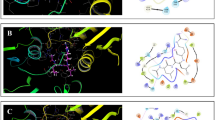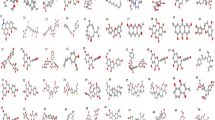Abstract
Malaria has remained one of the most devastating diseases, and the problem has further complicated due to wide spread of chloroquine (CQ)-resistance strain of Plasmodium falciparum. In order to overcome this problem, efforts are being made to develop new chemical entities that can solve the problem of drug resistance. In this context, both atom-based and field-based 3D-QSAR (3-Dimensional quantitative structure–activity relationship) studies were carried out for some of our recently reported 4-aminoquinoline hybrids. The four models generated have shown good correlation coefficients r 2 (0.97, 0.97, 0.94, and 0.95) and test set prediction coefficients q 2 (0.86, 0.88, 0.93, and 0.89). The 3D-QSAR models gave insights into the facts about the changes in the activity pattern with the change in pyrimidine, triazine, and triazole rings. These models will be useful in the future projects of developing new antimalarial compounds against both the CQ-sensitive and CQ-resistance strains of P. falciparum.
Graphical abstract













Similar content being viewed by others
References
Atheaya H, Khan SI, Mamgain R, Rawat DS (2008) Synthesis, thermal stability, antimalarial activity of symmetrically and asymmetrically substituted tetraoxanes. Bioorg Med Chem Lett 18:1446–1449
Brogi S, Papazafiri P, Roussis V, Tafi A (2013) 3D-QSAR using pharmacophore-based alignment and virtual screening for discovery of novel MCF-7 cell line inhibitors. Eur J Med Chem 67:344–351
Chang HW, Chung FS, Yang CN (2013) Molecular modeling of p38alpha mitogen-activated protein kinase inhibitors through 3D-QSAR and molecular dynamics simulations. J Chem Inf Model 53:1775–1786
Chen IJ, Foloppe N (2010) Drug-like bioactive structures and conformational coverage with the LigPrep/ConfGen suite: comparison to programs MOE and catalyst. J Chem Inf Model 50:822–839
Dixon SL, Smondyrev AM, Knoll EH, Rao SN, Shaw DE, Friesner RA (2006) PHASE: a new engine for pharmacophore perception, 3D QSAR model development, and 3D database screening: 1. methodology and preliminary results. J Comput Aided Mol Des 20:647–671
Free SM, Wilson JW (1964) A mathematical contribution to structure-activity studies. J Med Chem 7:395–399
Ghose AK, Viswanadhan VN, Wendoloski JJ (1998) Prediction of hydrophobic (Lipophilic) properties of small organic molecules using fragmental methods: an analysis of ALOGP and CLOGP Methods. J Phys Chem A 102:3762–3772
Golbraikh A, Tropsha A (2002) Beware of q2! J Mol Graph Model 20:269–276
Hansch C, Fujita T (1964) p-σ-π analysis. a method for the correlation of biological activity and chemical structure. J Am Chem Soc 86:1616–1626
Jabeen I, Wetwitayaklung P, Chiba P, Pastor M, Ecker GF (2013) 2D and 3D-QSAR studies of a series of benzopyranes and benzopyrano[3,4b][1,4]-oxazines as inhibitors of the multidrug transporter P-glycoprotein. J Comput Aided Mol Des 27:161–171
Jiang YK (2010) Molecular docking and 3D-QSAR studies on beta-phenylalanine derivatives as dipeptidyl peptidase IV inhibitors. J Mol Model 16:1239–1249
Krafts K, Hempelmann E, Skorska-Stania A (2012) From methylene blue to chloroquine: a brief review of the development of an antimalarial therapy. Parasitol Res 111:1–6
Kumar N, Khan SI, Beena, Rajalakshmi G, Kumaradhas P, Rawat DS (2009a) Synthesis, antimalarial activity and cytotoxicity of substituted 3,6-diphenyl-[1,2,4,5]tetraoxanes. Bioorg Med Chem 17:5632–5638. doi:10.1016/j.bmc.2009.06.020
Kumar N, Khan SI, Sharma M, Atheaya H, Rawat DS (2009b) Iodine-catalyzed one-pot synthesis and antimalarial activity evaluation of symmetrically and asymmetrically substituted 3,6-diphenyl[1,2,4,5]tetraoxanes. Bioorg Med Chem Lett 19:1675–1677
Kumar N, Khan SI, Atheaya H, Mamgain R, Rawat DS (2011a) Synthesis and in vitro antimalarial activity of tetraoxane-amine/amide conjugates. Eur J Med Chem 46:2816–2827
Kumar N, Sharma M, Rawat DS (2011b) Medicinal chemistry perspectives of trioxanes and tetraoxanes. Curr Med Chem 18:3889–3928
Kumar N, Khan SI, Rawat DS (2012a) Synthesis and antimalarial activity evaluation of tetraoxane triazine hybrids and spiro[piperidine-4,3′-tetraoxanes. Helv Chim Acta 95:1181–1197
Kumar N, Singh R, Rawat DS (2012b) Tetraoxanes: synthetic and medicinal chemistry perspective. Med Res Rev 32:581–610
Liu GY, Ju XL, Cheng J, Liu ZQ (2010) 3D-QSAR studies of insecticidal anthranilic diamides as ryanodine receptor activators using CoMFA, CoMSIA and DISCOtech. Chemosphere 78:300–306
Manohar S, Khan SI, Rawat DS (2010) Synthesis, antimalarial activity and cytotoxicity of 4-aminoquinoline-triazine conjugates. Bioorg Med Chem Lett 20:322–325
Manohar S, Khan SI, Rawat DS (2011) Synthesis of 4-aminoquinoline-1,2,3-triazole and 4-aminoquinoline-1,2,3-triazole-1,3,5-triazine hybrids as potential antimalarial agents. Chem Biol Drug Des 78:124–136
Manohar S, Rajesh UC, Khan SI, Tekwani BL, Rawat DS (2012) Novel 4-aminoquinoline-pyrimidine based hybrids with improved in vitro and in vivo antimalarial activity. ACS Med Chem Lett 3:555–559
Manohar S, Khan SI, Kandi SK, Raj KK, Sun G, Yang X et al (2013a) Synthesis, antimalarial activity and cytotoxic potential of new monocarbonyl analogues of curcumin. Bioorg Med Chem Lett 23:112–116
Manohar S, Khan SI, Rawat DS (2013b) 4-aminoquinoline-triazine-based hybrids with improved in vitro antimalarial activity against CQ-sensitive and CQ-resistant strains of Plasmodium falciparum. Chem Biol Drug Des 81:625–630
Moorthy NSHN, Ramos MJ, Fernandes PA (2011) hERG binding feature analysis of structurally diverse compounds by QSAR and fragmental analysis. RSC Adv 1:1126–1136
O’Neill PM, Bray PG, Hawley SR, Ward SA, Park BK (1998) 4-Aminoquinolines past, present, and future: a chemical perspective. Pharmacol Ther 77:29–58
Ridley RG (2002) Medical need, scientific opportunity and the drive for antimalarial drugs. Nature 415:686–693
Sapre NS, Jain N, Gupta S, Sapre N (2013) Ligand based 3D-QSAR modelling studies on 2-amino-6-aryl sulfonylbenzonitriles (AASBNs) as non-nucleoside reverse transcriptase inhibitors of HIV-1. RSC Adv 3:10442–10451
Shelley JC, Cholleti A, Frye LL, Greenwood JR, Timlin MR, Uchimaya M (2007) Epik: a software program for pK(a) prediction and protonation state generation for drug-like molecules. J Comput Aided Mol Des 21:681–691
Wang J, Li F, Li Y, Yang Y, Zhang S, Yang L (2013) Structural features of falcipain-3 inhibitors: an in silico study. Mol BioSyst 9:2296–2310
Wootton JC, Feng X, Ferdig MT, Cooper RA, Mu J, Baruch DI et al (2002) Genetic diversity and chloroquine selective sweeps in Plasmodium falciparum. Nature 418:320–323
Zhang S, Golbraikh A, Oloff S, Kohn H, Tropsha A (2006) A novel automated lazy learning QSAR (ALL-QSAR) approach: method development, applications, and virtual screening of chemical databases using validated ALL-QSAR models. J Chem Inf Model 46:1984–1995
Acknowledgments
DSR thanks University Grants Commission [F. No. 41-202/2012(SR)], New Delhi, India and University of Delhi, Delhi, India for financial support. KKR and SM are thankful to CSIR for the award of research associate ship and senior research fellowship, respectively. Authors thank Dr. M Ravi Kumar (Senior Application Scientist, Schrodinger. Inc, USA) for his suggestions.
Author information
Authors and Affiliations
Corresponding author
Supplementary Data
44_2014_1195_MOESM1_ESM.doc
Electronic Supplementary Information (ESI) available: [Field fractions of atom-based and field-based 3D-QSAR models and other information mentioned in manuscript]. Supplementary material 1 (DOC 267 kb)
Rights and permissions
About this article
Cite this article
Kranthi Raj, K., Manohar, S., Talluri, V.R. et al. Insights into activity enhancement of 4-aminoquinoline-based hybrids using atom-based and field-based QSAR studies. Med Chem Res 24, 1136–1154 (2015). https://doi.org/10.1007/s00044-014-1195-6
Received:
Accepted:
Published:
Issue Date:
DOI: https://doi.org/10.1007/s00044-014-1195-6




